Shanakill (Decies)
Houses within 10km of this house
Displaying 59 houses.
Houses within 10km of Shanakill (Decies)
Displaying 59 houses.
| House name | Description | |
|---|---|---|
| D'Loughtane | The Ronayne family were resident at D'Loughtane for many centuries. It was lost to the family in the 17th century but recovered through marriage with a Bluett. In the eighteenth century Smith refers to it as "the pleasant seat of Mr. Ronayne". The original house was destroyed by fire and a new one built in the early 19th century. At the time of Griffith's Valuation, it was held in fe by Robert P. Ronayne and valued at £26. The sale rental of June 1851 states that it was erected at a cost of £3,500. Knight writes that it was sold in the Encumbered Estates Court in 1856 to Mr Samuel Allen who sold it later to John Pedder Furlong of Fermoy. Furlong sold the property to the Land Commission in 1910. The house has had a number of occupiers since then and is now owned by the Smiddy family. |
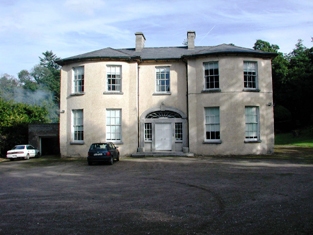
|
| Strancally Castle | John Keily held Strancally Castle in fee at the time of Griffith's Valuation, when it was valued at £61. Lewis refers to it as "a modern castle, seat of J. Keily" in 1837. There is a lithograph and extensive description of the castle and demesne in the sale notice of 1856. After this the castle came into the ownership of the Whitelock Lloyd family. In 1906 it owned by George W. Lloyd and valued at over £63. The 1943 ITA Survey provides a detailed description of the house from that time including the art collection and library. It is still extant and has been renovated in recent years. An extensive farmyard, valued at £37 in 1851, is located in Kilmanicholas townland at X078903. This property was valued at over £40 in 1906. |
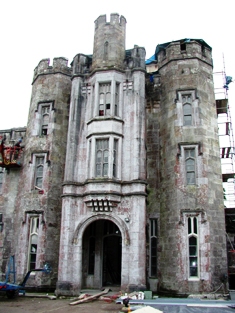
|
| Knockanore House | Rev. Thomas Queally was leasing a property at Knockanore valued at £10 10s from the Keily estate in 1851. It is not shown on the 6-inch Ordnance Survey Map but is labelled Knockanore House on the 25-inch map of the 1890s. The property appears to have fallen into disuse during the twentieth century. | |
| Headborough | At the time of Griffith's Valuation, Headborough was held in fee by Mrs. Catherine Smith [Smyth] and valued at £60. Lewis refers to it as the seat of Rev. Percy Scott Smyth in 1837. In 1906 it was owned by Percy Smyth with a valuation of £50. Smith mentions Headborough as the seat of William Smith. In 1943 the ITA survey notes that the stone used in its building was transported from county Kerry. It is still extant and occupied. |

|
| Janeville (County Waterford) | Janewille House was vacant at the time of Griffith's Valuation, when it was part of the Ussher estate and valued at £22 10s. A second house [X027936] in the same location was leased by Henry Smyth from the Ussher estate and valued at £15 10s. In 1837 Lewis refers to Janeville as the seat of A. Keily. Wilson, writing in 1786, refers to it as the seat of John Keily. The house is no longer extant. | |
| Moorehill | Held in fee by William Moore at the time of Griffith's Valuation, when it was valued at £55. Lewis also refers to it as his seat in 1837. Wilson, writing in 1786, notes it a the seat of Rev. Mr. Moore. In 1894 and 1906 it was the property of Captain William Perceval Maxwell and valued at over £70. In 1943 the ITA survey noted it as the residence of Captain Maxwell and mentioned that it was an eighteenth century house. It is still extant and occupied. | |
| Sapperton House | Held in fee by the Moore estate at the time of Griffith's Valuation, when it was valued at £37. It is described as a farm-house. Lewis refers to it as the seat of S. Moore in 1837. Wilson, writing in 1786, notes Sapperton as the seat of Major Moore. It was inherited by Willam Percival Maxwell. In 1906 he was the owner and the house was valued at £37. Sapperton, as well as its extensive farmyard, is still extant and occupied. |
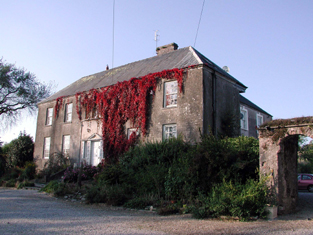
|
| Snugborough | In 1786 Wlson refers to Snugborough as the seat of Mr Smith. Mrs. Helena Greaves was leasing this property to Richard Walsh in 1851 when it was valued at £10 10s. An extensive farmyard complex still survives at the site. |

|
| Tourin and Tourin Castle | Tourin House was owned by Sir Richard Musgrave at the time of Griffith's Valuation, when it was valued at £41 10s. An earlier house, attached to Tourin Castle, is located nearby [X095965]. In 1850 it was valued at £49. In 1837, Lewis refers to this earlier Tourin House as the seat of Sir R. Musgrave, "composed partly of an ancient castle, commanding extensive and picturesque views".In 1906 the larger house had a valuation of £64 while the other buildings were valued at almost £10. The Musgrave estate still owned the properties. The ITA survey of the 1940s noted "Toureen" as the resident of Captain Jamison, formerly the property of the Musgraves. Both houses are still extant and occupied. |
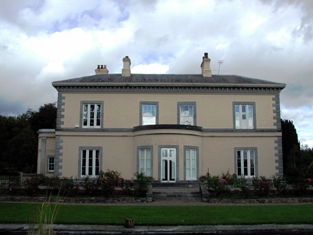
|
| Tourin Castle Farm | This property, valued at £3 in 1851, represents the original Musgrave property and attached to the ruins of Tourin fortified house. Smith refers to a castle at Tourin, owned by John Reeves Nettles and formerly in the hands of the Roches. |
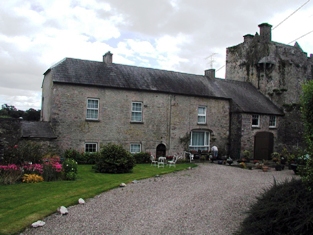
|
| Camphire House | Held in fee by Christopher Ussher in 1851 when it was valued at £28. It was the residence of Christopher M. Ussher in the 1870s. Buildings at this location were in the possession of the Ussher family in 1906 and valued at almost £6. In the 1940s the ITA survey noted that it was occupied by Mrs. Chearnley but owned by the Dobbs family and had formerly been a residence of the Ussher family. The Irish Army also seemed to have occupied part of the building during World War II. Camphire is still extant and occupied. |
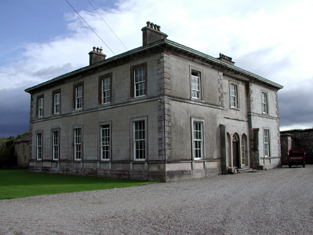
|
| Drumroe House (Waterford) | In 1851 this property was leased by Sir W.J. Homan from the estate of Mansergh St. George, when it was valued at £45. William Jackson Homan was a member of the Homan family of county Westmeath and married to Lady Charlotte Stuart. Local sources suggest he acted as a steward on the Dromana estate. The house is now a ruin. | |
| Tubbrid (Lismore) | In 1851 this property was held in fee by Townsend Keily and valued at £23 10s. The property is still extant and part of a large farming enterprise. | |
| Ballynatray House | Held in fee by Richard Smyth at the time of Griffith's Valuation when the buildings, including a mill, were valued at over £100. Lewis also refers to it as the seat of R. Smyth in 1837 when he describes it as "finely situated in a much improved demesne". In 1814 it was the residence of Grice Smyth who Brady cites as the builder. Charles Smith notes an earlier residence as the seat of Richard Smith. In 1943 the ITA survey referred to is as the seat of Captain Holroyd Smyth. Ballynatray is still extant and the focus of an 850-acres estate, with notable gardens. See www.ballynatray.com for details. |
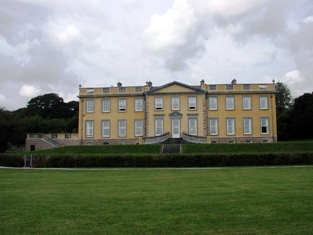
|
| Cherrymount House | Described by Lewis in 1837 as the "occasional residence" of Captain Parker. It was being leased by Thomas Carpenter from the Parker estate at the time of Griffith's Valuation, when it was valued at £24 10s. In 1852 it was offered for sale in the Encumbered Estates Court when it was described as "a suitable dwelling house and demesne, formerly occupied by the owner". It was purchased by Maj-Gen Sir Joseph Thackwell and remained in the possession of that family until the twentieth century. It is now a ruin. | |
| Garryduff House | Garryduff was held in fee by Thomas Garde at the time of Griffith's Valuation, when the buildings were valued at £35 10s. Lewis refers to it as the seat of H. Garde in 1837. This house is no longer extant. | |
| Aglish House (Decies) | Aglish House was leased by James O'Brien from the representatives of James Nagle, in 1851, when it was valued at almost £14. It is still extant and occupied. |
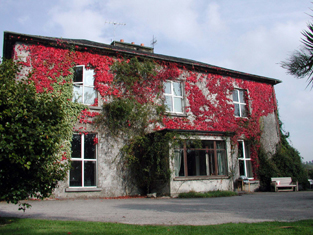
|
| Ballingowan House (South) | Robert Dower was leasing this property from William Villiers-Stuart at the time of Griffith's Valuation, when it was valued at £13 5s. A house still exists at this site. | |
| Bleach | At the time of Griffith's Valuation, Charles Graves was leasing property from the Villiers-Stuart estate which included a house and mill. The complex was valued at over £37. By the later nineteenth century Bleach House is shown here but the mill in not shown. A house is still extant at the site. | |
| Cooneen Mill | Charles Musgrave was leasing this extensive property from Sir Richard Musgrave at the time of Griffith's Valuation, when it was valued at £31 5s. It is recorded as disused on the 25-inch Ordnance Survey Map of the 1890s. Some ruins remain at the site. | |
| Ballynaparka House | In 1851, this house was held in fee by Thomas J. Fitzgerald and valued at over £31. Leet had recorded it as the seat of Patrick Dwyer in 1814. In 1906 it was still the property of the Fitzgerald estate and valued at over £10. There is still a house at this location. | |
| Tinnascart House | In 1851 this property was leased by Robert Dower from William C. Poole when it was valued at £14 10s.The 1874 Dower estate sale notice indicates that the house had been built within the previous 15 years at a cost of £2000. It is labelled as Tinnascart House on the 25-inch Ordnance Survey map of the later nineteenth century. The location is now a racehorse training enterprise. | |
| Villierstown House | In 1851 leased by Rev. Hans Butler from the Villiers Stuart estate when it was valued at £14 5s. Still extant and occupied. |

|
| Ardsallagh House | Mrs.Olivia Ronayne was leasing this property from the estate of Lord Stuart de Decies at the time of Griffith's Valuation, when it was valued at £10 10s. It is labelled Ardsallagh House on both the 6-inch and 25-inch Ordnance Survey maps. Extant buildings remain at the site. | |
| Laurentum | At the time of Griffith's Valuation, Richard Coughlan was leasing this property from the Villiers-Stuart estate, when it was valued at £11. It does not appear on the 6-inch Ordnance Survey map but is named as Laurentum on the later 25-inch map. There is still an extant house at the site. | |
| Ballynamultina House | Francis Kennedy was leasing this property from the Mansfield estate at the time of Griffith's Valuation, when it was valued at £18 10s. Leet also refers to it as his residence in 1814. Smith states it was the seat of Mr. Mansfield in the late eighteenth century. A house is still extant at the site. | |
| Clashmore | Clashmore was held in fee by the Earl of Huntingdon at the time of Griffith's Valuation, when it was valued at £34. The site marked on the 1st-edition Ordnance Survey map is not that recorded on the later 25-inch map. Smith refers to the earlier house as the seat of Mr. Power and Wilson refers to it as the seat of Richard Power in 1786. The Irish Tourist Authority Survey of the 1940s suggest the later house was never fully completed and by then had all but disappeared. Much of the extensive farmyard, however, is still extant and in use. |
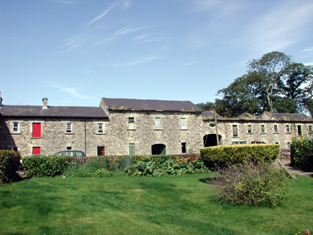
|
| Bayview (Clashmore) | Rev. Michael Purcell was leasing this property from Lord Decies estate in 1851 when it was valued at £12. There is still an extant house at this site. | |
| Rockview (Clashmore) | Leased by Richard Bayley from the Villiers-Stuart estate at the time of Griffith's Valuation, when it was valued at almost £7. It is labelled Rockview on both the 6-inch and 25-inch Ordnance Survey maps. There is still an extant house at the site. | |
| Glenlicky Mill | At the time of Griffith's Valuaton Rev. James Elliott was leasing this substantial property to Thomas Page, when it was valued at £44. It included a house and mill. Noted on the 25-inch Ordnance Survey Map of the later nineteenth century as Glenlicky Mill. The buildings are now ruinous. | |
| Lackendarra House | In 1851, Mrs. Eleanor Fitzgerald was leasing this property from Rev. James Elliott when it was valued at £11 5s. In 1894 it appears to have been occupied by a Russell family. | |
| Pilltown House | Declan Tracy was leasing this property from the Kennedy estate at the time of Griffith's Valuation, when it was valued at over £12. Smith refers to it as "Pilltown, not long since the estate of the Walshes". The house is labelled Pilltown House on the 25-inch map of the 1890s. It is no longer extant. Tracy is noted as the owner of over 450 acres in county Waterford in the 1870s. A substantial mill, valued at £39, in the same townland was being leased by Peter Moore Fisher [X129800]. It was included in the sale of Fisher property in the Landed Estates Court in November 1865. The mill appears to have fallen into disuse by the end of the nineteenth century though the ruins remain. | |
| Affane House | Held in fee by Samuel Browning Power in 1851 when it was valued at £32. Lewis refers to it as the seat of S. Power in 1837. It was the property of Samuel J. Power in 1906 and still valued at £32. Brady notes that the house incorporates material from the late seventeenth century house owned by the Greatrakes famly. In the 1780s Taylor and Skinner refer to it as a residence of the Browning family. It is now almost a ruin. |

|
| Belleville Park (Affane) | George B. Power held Belleville Park in fee at the time of Griffith's Valuation, when it was valued at £39. Lewis noted it as the seat of S. Poer in 1837. Wilson, writing in 1786, mentions "Bettytville" as the seat of Pierce Power. The ITA survey states that it was afterwards occupied by members of the Tanner and Wyse families. At the time of the survey, in 1942, it was the home of Richard Keane, It is still extant and occupied. |
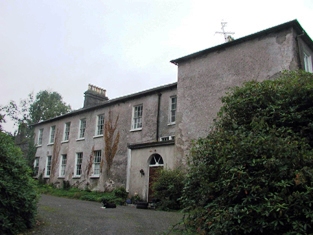
|
| Richmond House (Affane) | Maj John H. Alcock was leasing this property from Henry Dennehy at the time of Griffith's Valuation when it was valued at £29. Lewis also noted it as his seat in 1837. The National Inventory of Architectural Heritage indicates it was also linked with the Villiers Stuart family. It is still extant and occupied. |

|
| Dromana | The seat of the Villiers-Stuart family, Lord Stuart de Decies, and held in fee by them in 1851 when it was valued at £101. In 1837 Lewis had noted that "its hanging gardens presents a picturesque and interesting feature". Charles Smith, referring to it as a noble seat of the Earl of Grandison, provides a detailed description of how it looked in the later eighteenth century. An account of its appearance in the 1940s is given in the Irish Tourist Association files. The National Inventory of Architectural Heritage indicates it is a seventeenth century house possibly incorporating parts of a medieval tower house. It was later extended and renovated but this Georgian extension was demolished in the 1960s leaving the original seventeenth century building. It is occasionally open to the public. |
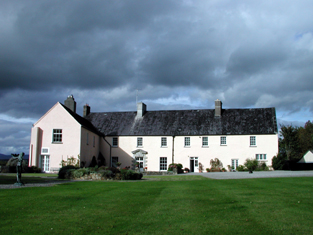
|
| Derriheen House | In 1851 Mrs. Grace Mansfield was occupying this property, which was in the hands of the Court of Chancery at the time. It was valued at £24. It is still extant and occupied. Lewis refers to it in 1837 as the seat of C. Maunsell. |
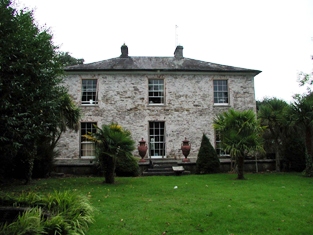
|
| Monyvroe | In 1851 Edmund Power held this property from Lord Decies estate when it was valued at £11 10s. There are still extant buildings at the site. | |
| Mountrivers (Affane) | In 1851, Sir Charles Shaw was leasing this property from the Gumbleton estate when it was valued at £27. The Villiers Stuart Papers in PRONI suggest Shaw was the head agent for that estate from the late 1840s.Lewis refers to it as the seat of Rev. G. Gumbleton in 1837. Mountrivers was demolished in the 1990s. A nearby property [X104975]. valued at £15, was held by Shaw from the Musgrave estate and used as a fever hospital. |

|
| Ballyguiry | James Wall was leasing this property from Lord Decies estate in 1851 when it was valued at £11 10s. There are still extant buildings at the site. | |
| Curraghamoreen House | Rev. John O'Meara was leasing this property from the Villiers-Stuart estate in 1851 when it was valued at £14. The house is still extant and undergoing renovations. | |
| Bewley | Captain Wiliam Chearnley was leasing this property to Geoffrey Norris at the time of Griffiths Valuation when it was valued at over £9. A farm is still extant at the site. | |
| Woodstock House (County Waterford) | John Hackett was leasing this property to Thomas Walsh in 1851 when it was valued at £21. It was included in the sale notice for the Walsh estate in May 1851 where it is noted that "a sum of over £2000 was expended in building the mansion". The house appears to have also been known as Whitechurch House. In 1894 Slater refers to it as the seat of Lt-Col. Charles Hely. The ruin of the original house was still visible until this century but a modern building occupies the site now. | |
| Rockfield (Modelligo) | Pierce Hely held this property in fee at the time of Griffith's Valuation, when it was valued at £33 10s. Wilson, writing in 1786, refers to "Rockville" as the seat of Mr. Hely. The house is still extant and occupied. The National Inventory of Architectural Heritage notes its association, not only with the Hely family, but also that of English and Grove-White. |

|
| Lackandarra Lodge | At the time of Griffith's Valuation, Richard Chearnley held this property in fee when it was valued at almost £10. On the 25-inch Ordnance Survey Map of the 1890s it is labelled Lackandarra Lodge. A farm is still extant at the site. | |
| Lackandarra A | Mrs. Eleanor Power was leasing this property from the Chearnley estate at the time of Griffith's Valuation, when it was valued at £9. There are still buildings extant at the site. | |
| Johnstown House (Decies) | Mrs. Mary Barron was leasing this property from the Villiers-Stuart estate in 1851 when it was valued at £10 10s. There is still an extant property at the site. | |
| Clonkerdin House | Mrs Catherine Quinlan was leasing this property from Lord Stuart de Decies in 1851 when it was valued at £30. It is still extant and occupied. In 2014 it was offered for sale. |

|
| Barranastook | In 1851 Simon Brien was leasing this property from the Musgrave estate when it was valued at £12. In 1906 Sir Richard Musgrave still held buildings at Barranastook valued at £1 10s. | |
| Ballintaylor | In 1851 Thomas Egan (junior) was leasing this property from the Musgrave estate when it was valued at £11. It was still part of the Musgrave estate in 1906 when it was valued at £9 10s. Leet had noted it as the seat of Maurice Power in 1814. Smith states that it was the seat of the Usher family having formerly been in the possession of the Osborne estate, a house being built here by Sir Richard Osborne in 1619. The property is no longer extant. | |
| Whitechurch | In 1851 this property was held in fee by Florence McCarthy when it was valued at £32. Local sources suggest it was once part of the Earl of Huntingdon's estate. The ITA survey noted that it had previously been the property of Dr. Forsythe, and, from the 1920s onwards, owned by the McGrath family. It is still extant and used as self-catering accommodation. |
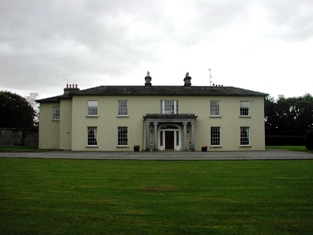
|
| Cappagh House (Old) | Richard Ussher held this property in fee in 1851 when it was valued at £41. This is the original Cappagh House, built by the Ussher family in the late eighteenth century and referred to in 1774 by Smith as the seat of John Usher. It is still extant, though replaced, in the late nineteenth century, by the modern Cappagh House. |
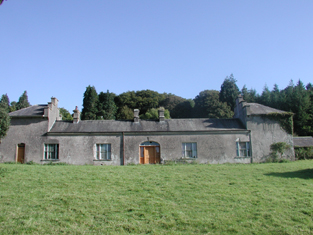
|
| Cappagh House | A house constructed in the later nineteenth century by Richard J. Ussher. In 1906 it was owned by him and valued at over £52. In 1942 the ITA survey notes it as the property of Percy Arnold Ussher. It is still extant and occupied. |
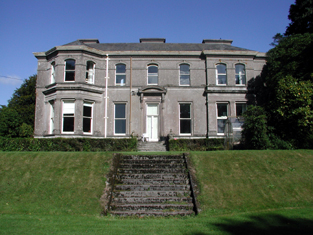
|
| Cappagh A | John Morrissy was leasing this property from the Ussher estate in 1851 when it was valued at £13. An extensive farm property still exists at the site. | |
| Carriglea House | Built by John O'Dell in the early ninetenth century, in 1851 this property was held in fee by Edward O'Dell when it was valued at £59. On the 25-inch Ordnance Survey map of the 1890s it is labelled Carriglea Convent. It is still extant and a centre for care services. |

|
| Mountodell | In 1851 this property was being leased by Rev. Edward Ellis from the Odell estate when it was valued at £9. In 1774 Charles Smith stated it was a seat of the Odell family as did Wilson in 1786. The property is still extant. | |
| Lauragh | Matthew Walsh was leasing this property from the Musgrave estate at the time of Griffith's Valuation, when it was valued at £12. | |
| Nicholastown Mill | Beresford Power was leasing this property to Walter Collander at the time of Griffith's Valuation, when it was valued at £11. The ruin of the building still remains at the site. | |
| Littlebridge | In 1786, Wilson refers to Littlebridge as the seat of Andrew English. By the time of Griffith's Valuation, this area was part of the estate of Sir Richard Keane. |

